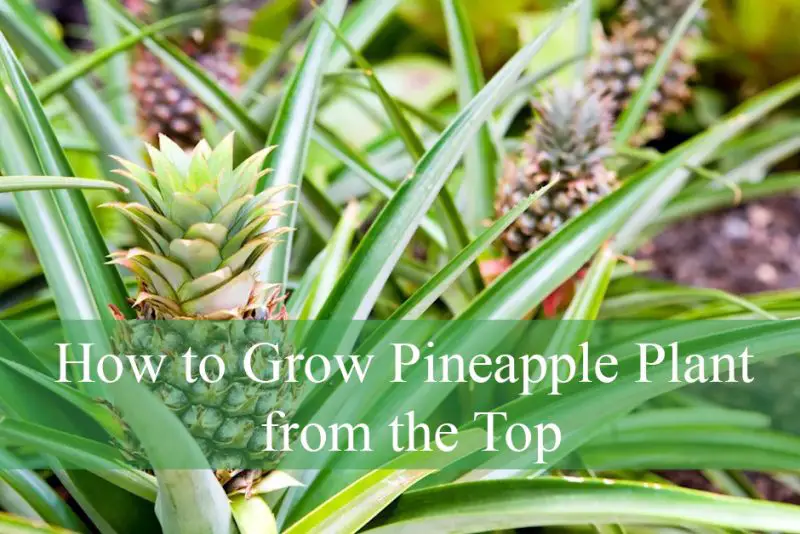Growing a pineapple plant from the top is not just a fun gardening experiment—it’s also an incredibly rewarding way to produce your very own tropical fruit at home. With the right conditions, a little patience, and consistent care, you can transform the leafy top of a store-bought pineapple into a thriving plant that eventually rewards you with sweet, juicy fruit.
This guide walks you through everything you need to know to ensure success, from preparing the pineapple crown to harvesting your first homegrown pineapple.
Understanding the Basics of Pineapple Propagation

Pineapples belong to the bromeliad family, which makes them unique among fruit-bearing plants. Instead of growing from seeds, pineapples can be easily propagated from various parts of the plant, including the crown or leafy top. When you cut off the top of a mature pineapple and give it the right growing environment, the crown can sprout roots and develop into a healthy plant.
This method of propagation mimics the way pineapples naturally reproduce in the wild. In their native tropical environments, pineapple tops fall to the ground and root themselves in soil. Over time, they establish new plants, repeating the cycle. By mimicking this natural process at home, you can successfully grow your own pineapple plant using only the crown of a ripe fruit.
The simplicity of this method is part of its appeal. It doesn’t require special tools, advanced gardening skills, or even a large amount of space. As long as you start with a healthy fruit and follow a few essential steps, you’ll be well on your way to growing pineapples right from your backyard, balcony, or even windowsill.
Choosing the Right Pineapple for Propagation
To ensure success, the first step is selecting the right pineapple. Not all fruits sold in stores are ideal for propagation, and choosing a healthy, mature specimen can make a big difference in the rooting process. Look for a pineapple with green, fresh-looking leaves and a firm, golden-yellow body. Avoid fruits with withered or brown leaves, moldy spots, or soft, overly ripe flesh.
The leaves of the crown should be vibrant and free of pests or damage. When you gently tug at the leaves in the center, they should resist easily. If they come out too quickly, the fruit may be overripe and less suitable for rooting. The base of the crown, where it attaches to the fruit, should be firm and intact. This portion contains the tissue necessary for sprouting new roots.
While you might be tempted to start with a pineapple from the refrigerated section, fresh pineapples kept at room temperature tend to root better. Cold storage can sometimes damage the crown tissue, reducing the chances of successful propagation. Buying local or freshly harvested pineapples gives you the best odds of finding a viable crown for planting.
Preparing the Pineapple Crown for Rooting
Once you have selected the perfect pineapple, the next step is removing and preparing the crown. This part of the process requires care to avoid damaging the base of the crown, which is where roots will emerge. Use a sharp, clean knife to slice off the leafy top of the pineapple, making the cut about half an inch below the leaves. This gives you a small portion of the fruit flesh to work with.
After separating the crown, gently strip away the lower leaves—about five to ten of them—until you expose the small root buds at the base. These tiny brown nubs are where new roots will form. Removing the lower leaves also prevents them from rotting when the crown is placed in water or soil.
It’s important to let the prepared crown dry out for a day or two before planting. This allows the cut end to form a protective callus, reducing the risk of rot when placed in a moist environment. Place the crown in a dry, shaded area with good air circulation and avoid direct sunlight during this curing phase.
Rooting the Crown in Water or Soil
After curing the crown, you have two main options for rooting: water propagation or direct planting in soil. Each method has its advantages, and your choice may depend on your climate, indoor conditions, and personal preference.
If you choose to root in water, place the cured crown in a glass or jar filled with water so that the base is submerged but the leaves remain dry. Use toothpicks to suspend the crown over the rim of the glass if needed. Place the jar near a sunny window, and change the water every few days to prevent stagnation. Within two to four weeks, you should see roots beginning to emerge.
For direct soil planting, use a small pot filled with well-draining potting mix. A cactus or succulent mix works well because it allows excess moisture to escape, reducing the risk of rot. Insert the base of the crown into the soil and press gently to stabilize it. Water lightly and place the pot in a warm, sunny spot. Keep the soil slightly moist but not wet, and avoid overwatering during the early stages.
Regardless of the method you choose, warmth and sunlight are key to successful rooting. Pineapple plants thrive in temperatures between 70°F and 85°F. During colder months, consider using a heat mat or grow light to provide consistent warmth and light.
Transplanting to a Larger Container or Garden Bed
Once the crown has developed a healthy root system, usually within six to eight weeks, it’s time to move the plant to a larger growing space. If you started in water, carefully transfer the rooted crown into a pot with well-draining soil. If the plant was already in a small pot, you can simply repot it into a larger container.
Choose a container that allows for at least 12 inches of root space and has drainage holes at the bottom. Pineapples are slow-growing but need room to expand their root systems over time. Use a light, sandy soil mix, and make sure the container is placed in a warm, sunny location.
If you live in a tropical or subtropical region, you can transplant the pineapple plant directly into your garden. Choose a sunny, well-drained area protected from strong winds. Raised beds or mounds work well to prevent waterlogging. Water the plant thoroughly after transplanting and monitor it closely as it adjusts to its new environment.
Caring for Your Pineapple Plant as It Grows
As your pineapple plant begins to grow, consistent care becomes essential for healthy development. Watering should be done sparingly, allowing the soil to dry slightly between sessions. Pineapple plants are drought-tolerant and more likely to suffer from overwatering than underwatering.
Sunlight is one of the most critical elements for success. Pineapples require at least six to eight hours of direct sunlight per day. If you’re growing indoors, a south-facing window or supplemental grow light is ideal. Without adequate light, the plant’s growth will be stunted, and fruiting may be delayed.
Fertilization supports healthy foliage and eventual fruit production. Use a balanced, slow-release fertilizer or a liquid feed designed for tropical plants. Apply fertilizer every two to three months during the growing season. Avoid heavy feeding, as this can damage the roots and foliage.
Over time, you’ll notice the plant producing new leaves from its center. These indicate healthy growth. In ideal conditions, the plant will grow steadily for 18 to 24 months before initiating flowering. Environmental stress, such as cool temperatures or low light, can delay this process, so maintaining consistency is key.
Encouraging Flowering and Fruiting
Getting a pineapple plant to flower can be a test of patience, but there are methods to encourage this phase once the plant reaches maturity. In nature, flowering is triggered by environmental cues like temperature changes or chemical signals. At home, you can mimic these cues to jump-start the process.
One popular method is the use of ethylene gas, which can stimulate blooming. This can be done by placing the pineapple plant inside a large plastic bag with a ripe apple for several days. The apple emits ethylene gas, which encourages the plant to initiate flower development. After a week, remove the bag and return the plant to its sunny spot.
Once flowering begins, you’ll see a red or purple bud emerge from the plant’s center. This bud will develop into a small flower cluster, eventually forming the base of the pineapple fruit. The flowering process lasts several weeks, followed by months of fruit development. On average, it takes five to seven months from flowering to harvest.
Throughout this phase, continue regular watering and fertilization. As the fruit grows, support the stem if necessary to prevent breakage. The pineapple will gradually grow in size, turning golden as it ripens. Once the fruit emits a sweet aroma and the body turns fully yellow, it’s ready to harvest.
Harvesting and Enjoying Your Homegrown Pineapple
Harvesting your pineapple is the most rewarding part of the process. After months of care, your plant will finally produce a fruit you can enjoy fresh from the garden. Use a sharp knife to cut the fruit from the base, taking care not to damage the surrounding leaves.
A homegrown pineapple may be smaller than commercial varieties but often has a sweeter, more intense flavor. Let it ripen for a day or two at room temperature before slicing into it. The golden flesh is perfect for eating fresh, blending into smoothies, or adding to desserts.
After harvesting, the main plant may produce side shoots or “pups” from its base. These offshoots can be separated and replanted to start the cycle again. With proper care, you can enjoy a continuous supply of pineapple plants year after year—all starting from a single crown.
Common Problems and Troubleshooting
Even with careful attention, pineapple plants can encounter issues during their growth cycle. One common problem is root rot, typically caused by overwatering or poorly draining soil. If the leaves begin to yellow or wilt, inspect the roots for signs of mushiness or decay. Let the soil dry out, and consider repotting into a fresh mix.
Pests such as mealybugs or spider mites can affect both indoor and outdoor plants. Keep an eye out for sticky residue or webbing on the leaves. Natural insecticidal soap or neem oil treatments can usually resolve these infestations without harming the plant.
Slow growth or failure to root is often related to insufficient light or cold temperatures. Make sure your plant is kept in a warm, sunny location, especially during the rooting and early growth stages. Supplemental light may be necessary if you’re growing in a low-light environment.
Frequently Asked Questions About Growing Pineapple from the Top
How long does it take to grow a pineapple from the top?
Growing a pineapple from the top typically takes between 18 to 24 months before the plant produces a flower. After flowering, it takes another 5 to 7 months for the fruit to mature. The exact timeline depends on factors such as temperature, light, and overall care, so consistency is key for quicker results.
Can I grow a pineapple indoors?
Yes, pineapples can be successfully grown indoors if they receive enough light and warmth. A sunny south-facing window is ideal. If natural light is limited, you can supplement with a grow light to ensure the plant gets the six to eight hours of daily light it needs to thrive and eventually fruit.
Do I need to use rooting hormone for pineapple tops?
Rooting hormone is not required to propagate a pineapple top. The crown naturally contains root buds, and with proper preparation and care, it will root on its own. However, using a rooting hormone may slightly speed up the process in some cases, especially in cooler climates.
What type of soil is best for pineapple plants?
Well-draining, sandy soil is best for growing pineapples. A cactus or succulent potting mix works well, as it prevents water from accumulating around the roots. Avoid using heavy or clay-based soil, which retains too much moisture and can cause root rot.
Will a pineapple plant produce more than one fruit?
Each pineapple plant produces only one fruit per growing cycle. However, after the fruit is harvested, the plant may develop side shoots called “pups.” These can be removed and replanted to grow new pineapple plants, continuing the cycle with multiple harvests over time.
What’s the best time of year to start growing pineapples?
You can start growing pineapples indoors at any time of the year. However, if you’re planting outdoors, spring or early summer is ideal to ensure the plant gets the warmth and sunlight it needs during its early growth phase. Tropical or subtropical climates are best suited for outdoor growth.
Final Thoughts on Growing Pineapple from the Top
Growing a pineapple plant from the top is a journey that combines patience, consistency, and a touch of tropical magic. From choosing the right fruit to nurturing it through to harvest, every stage offers opportunities to learn and connect with the natural world. Whether you’re a beginner gardener or simply curious about propagating fruit at home, the experience is both accessible and deeply satisfying.
The best part? You don’t need to live in a tropical paradise to grow your own pineapple. With a little care and a lot of sunlight, you can bring a taste of the tropics to your home—one sweet, juicy pineapple at a time.






